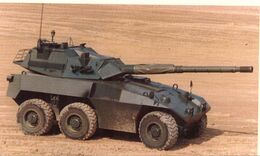The EE-17 Sucuri is an armored vehicle fighting developed by Engesa in Brazil.
Description[]
Its primary function was to be a tank destroyer, although the chassis' versatility was another selling point. It was designed during a period of great change within the Brazilian military industry during the 80s. Several projects were presented by Brazilian companies, among which stood out clearly ENGESA S. José dos Campos (SP).
A company produced the EE-9 Cascavel armored vehicles personnel carriers and armored reconnaissance Cascavel, equipped with 90mm cannon in slow speed.

EE-17
With emerging markets in mind, but also the possibility of orders from the Brazilian army to a more powerful vehicle than the Cascavel but with great mobility, ENGESA drew a national battle tank and an armored vehicle but relatively unprotected well armed, capable of engaging the most powerful vehicles of surprise and use his speed to escape from being destroyed, the Sucuri.
Initially the Sucuri was to be equipped with the FL-12 which boasted a 105mm caliber and an oscillating turret. This turret was used in the SK-105 Kürassier.
Later, because the French turret was considered complex, expensive, and because of the difficulty faced by Engesa to sell the vehicle, it was decided by ENGESA to build a turret of his own, which also led to an exchange of cannon on the other, of Italian origin and based on L-7 cannon 105mm. With this new cannon, the Sucuri-II now had chance to shoot the arrow piercing ammunition, which was most effective against armored vehicles, even heavy armored vehicles.
The new tower was eventually result in a complete redesign of Sucuri transforming it into a vehicle far superior to its predecessor. With a new lower profile and better ballistic profile front. The new tower was also the result of studies Engesa for the vehicle he was studying at the moment, the medium tank EE-T1 Osorio. For a vehicle designed in the mid 80s, the Sucuri was very well equipped with periscopes for commander and gunner and a laser rangefinder, spinstabilized cannon, which can make searching for targets when the vehicle is in motion.
The new engine, along with the new tower, reduced weight of Sucuri-II to 18 tonnes or 500 kg. Unless the 18500 kg the initial model of Sucuri.
The Sucuri-II could be assisted very easily and its engine was easy to remove.
He was but a landmark in the Brazilian military industry, because while with the other vehicles to Brazil merely copy concepts and ideas from other countries, with Sucuri-II - a light tank on a 6x6 platform - there was an attempt to innovate that was not completely novel, was at least the idea that this type of vehicle might be successful in the future, at least for the conditions of Latin America as a replacement of the vehicle of the EE-9 Cascavel.
Weapons and Armour[]

EE-18 Sucuri II
EE-18 was equipped with a cannon fully giroestabilizado L7 105mm made under license by Otomelara, which can fire ammunition standard NATO can penetrate 150 mm armor to 5000 meters range. The secondary armament consists of a machine gun and 12.7 mm caliber and one 7.62 mm coaxial machine gun. The vehicle is equipped with a modern system of firefighting. It's armor hull and turret are welded composite armor. Shielding protects against frontal shots of 20-25mm and against small arms fire and shrapnel from artillery just around the whole vehicle. NBC protection system was not offered as standard. The crew is composed of four people entering and leaving through a back door which also serves to load the ammunition.
Specifications[]
Dimensions[]
- Length: 7.75m
- Height: 2.59m
- Width: 2.8m
- Weight: 18.5 tons
Performance[]
- Engine: Saab-Scania DSI-11 diesel
- Engine Power: 380 hp
- Max Speed: 105 km/h
Armament[]
- Main Gun: 1x 105mm gun
- Secondary gun: 1x M2 Browning
See also[]
The original article can be found at EE-17 Sucuri and the edit history here.